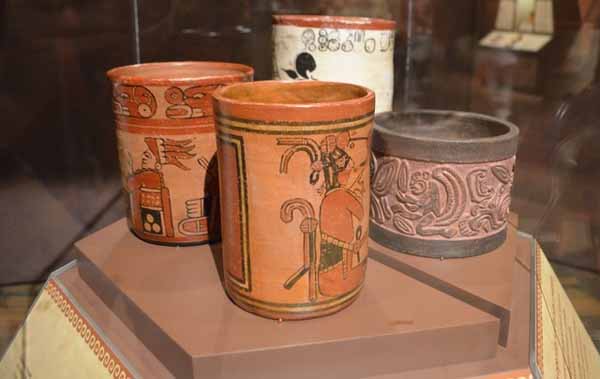By 1585, when Europeans got their first taste of chocolate, cacao had been a major part of Mayan, Aztec and other Mesoamerican societies for over a thousand years.
The first Spanish shipment of cacao beans, the seeds of the fruit of the cacao tree and the raw form of modern-day chocolate, landed in Europe late in the 16th century. It arrived from the New World, where the conquistadors were introduced to the beans and their profound significance in what is now Mexico and Central America.
Early History of Chocolate
Archaeological evidence suggests the Mayans, whose civilization flourished between 250 and 900 C.E., were the first to cultivate cacao but its importance in Mesoamerica is much older; according to Sophie D. Coe in her book, “The True History of Chocolate,” a word for cacao, kakaw, existed in the Olmec vocabulary as early as 1000 B.C.E. Cacao was consumed solely as a beverage, typically unsweetened and preferred hot by the Mayans and cold by the Aztecs, who occupied the Valley of Mexico from 1325-1521 C.E. Its recipe was complex; ripe pods were fermented and the seeds inside were dried, toasted, peeled, and ground on a stone slab. The resulting paste was mixed with chili peppers or cornmeal and made into a bitter drink by adding water and pouring from one jug to another until a thick foam head appeared and its texture was like honey, a process illustrated on at least one surviving Mayan drinking vessel. Later versions of the drink included the addition of various native plants, honey or vanilla. Mesoamerican groups shared the name xocoatl for this important beverage and the Aztecs named the cacao beans cacahuatl in their Nahuatl language.
About Chocolate as a Status Symbol
In Aztec society, xocoatl was primarily reserved for the upper classes. Moctezuma, ruler at the time of the Spanish conquest, reportedly had 50 portions prepared in golden chalices for his own daily use, and another 2000 were whipped up for the rest of his household. Xocoatl supposedly had both strength-giving and aphrodisiac qualities; the army consumed it before battle and Moctezuma guzzled some before spending time with his harem. The beverage was an important part of banquets, served only at the end of a meal.
Chocolate Used as Currency
The conquistadors noted the importance of cacao to the Mesoamericans early on. Cacao was more than just a drink; the beans were also used as hard currency. The Aztecs, unable to cultivate cacao trees in their valley, initially traded for the beans with the Mayans. But as the Aztec empire expanded, conquered peoples were forced to pay the beans to the state as taxation. A surviving Nahuatl document written in 1526 gives an indication of cacao’s commercial value: a good turkey hen could be purchased for 100 beans, a freshly picked avocado or an egg cost 3 beans, and a ripe avocado or a tomato were worth a single cacao bean. In Nicaragua, a decent slave cost 100 beans and the services of a prostitute were available for 10 beans.
The Religious Significance of Chocolate
In addition to its social and economic worth, cacao was important in Mesoamerican ritual and religion. Numerous references to cacao appear in the Mayan creation myth, The Popol Vuh, as well as in the Dresden and the Madrid Codices, two of only four surviving examples of Mayan books. In Aztec mythology, cacao is associated with the god Quetzalcoatl and devotees offered him beans during ceremonies. For the Mayans, it was customary for couples to share drinks of xocoatl during weddings and cacao was also part of a Yucatan baptismal anointment. Cacao was even important after death; drinking vessels marked with the telltale Mayan glyph have been found in tombs. Most dramatically, cacao played a role in Aztec human sacrifice rituals: victims were reportedly given xocoatl as their last meal. Some of these religious practices have survived to the present day, notably among the Lacandon Maya in Chiapas, Mexico.
New Discoveries About Chocolate’s History
As much as we know about chocolate’s early history, the story remains incomplete. In 2002, University of Texas researchers discovered chemical remains of cacao in vessels dating between 600-400 B.C.E., the oldest direct evidence of cacao consumption found yet. And in 2006, a stone tablet inscribed with what may be the first unearthed example of Olmec script was found in Mexico; according to a 2006 National Geographic article, an analysis by one language expert has suggested that two of the 30 identifiably separate symbols may be representations of cacao pods. These discoveries, as well as the many finds certain to come in the future, may well expand our understanding of the early history of chocolate.
Sources:
- Coe, Sophie D. and Michael D. Coe. “The True History of Chocolate.” London: Thames & Hudson, 1996.
- Inman, Mason. “Oldest Writing in New World Discovered, Scientists Say.” National Geographic. 14 Sept 2006.
- “University of Texas at Austin Researchers Discover Earliest Documented Use of Chocolate.” University of Texas at Austin News. 18 Jul. 2002








